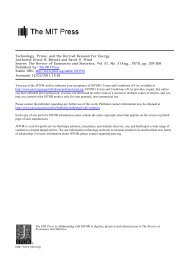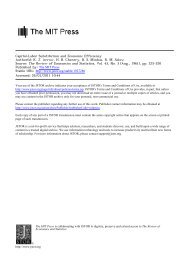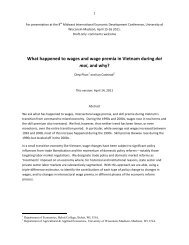Status of Wisconsin Agriculture 2010 - Agricultural & Applied ...
Status of Wisconsin Agriculture 2010 - Agricultural & Applied ...
Status of Wisconsin Agriculture 2010 - Agricultural & Applied ...
Create successful ePaper yourself
Turn your PDF publications into a flip-book with our unique Google optimized e-Paper software.
Spatial Expansion <strong>of</strong> Organic Dairy Farms in Southwest <strong>Wisconsin</strong><br />
Legend<br />
• Organic farms<br />
•<br />
•<br />
Conventional farms<br />
* Organic Valley<br />
★✪<br />
★✪<br />
5 organic farms<br />
ers commensurate with the cooperative’s penetration<br />
and sales growth in new markets. Each year, contracts<br />
with members coordinate on both price and quantity.<br />
Members seeking to make significant expansions or<br />
increases in production need the Organic Valley’s<br />
explicit permission to add more milk to the cooperative’s<br />
regional pool. In periods <strong>of</strong> rapid demand growth,<br />
quantity restrictions were not much <strong>of</strong> an issue, but they<br />
were written into the contract and in producer’s expansion<br />
plans. This meant that joining Organic Valley<br />
Cooperative was easier during periods <strong>of</strong> initial expansion<br />
into markets than when it had become established<br />
in a market, unless demand growth was strong enough<br />
to warrant adding new members. In other words, for<br />
Organic Valley Cooperative, a fundamental aspect <strong>of</strong><br />
★✪<br />
1998 2001<br />
2004<br />
81 organic farms 131 organic farms<br />
46 STATUS OF WISCONSIN AGRICULTURE <strong>2010</strong>—FRAMING THE FINANCIAL CRISIS<br />
★✪<br />
39 organic farms<br />
★✪<br />
2008<br />
developing an effective supply management strategy<br />
has been limiting the number and rights <strong>of</strong> members<br />
and coordinating their production. To reiterate, this<br />
approach is not novel to cooperatives. There is a long<br />
history <strong>of</strong> such efforts, as cooperatives have legal rights<br />
to try to shape supply conditions in a way that private<br />
firms do not.<br />
It is no accident that in 2009, when it faced the end <strong>of</strong><br />
tremendous demand growth and the prospect for much<br />
lower prices, Organic Valley had the supply management<br />
architecture in place to deploy. It was part <strong>of</strong> the<br />
cooperative’s original organizational design, available<br />
when needed. When it was needed, the cooperative’s<br />
leadership activated it. Of course, it did not hurt that<br />
Organic Valley was a national market leader <strong>of</strong> organic







